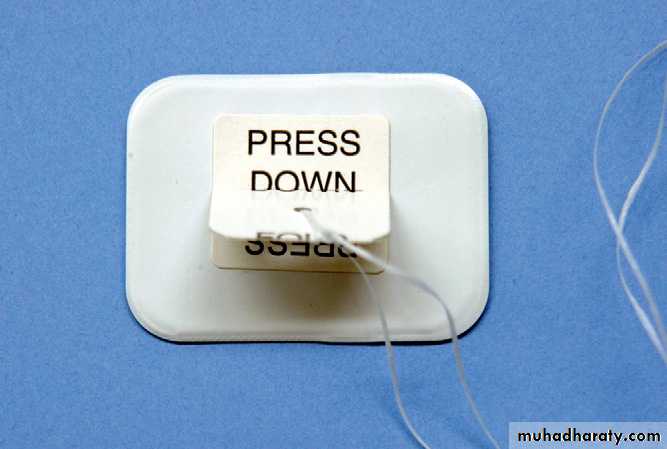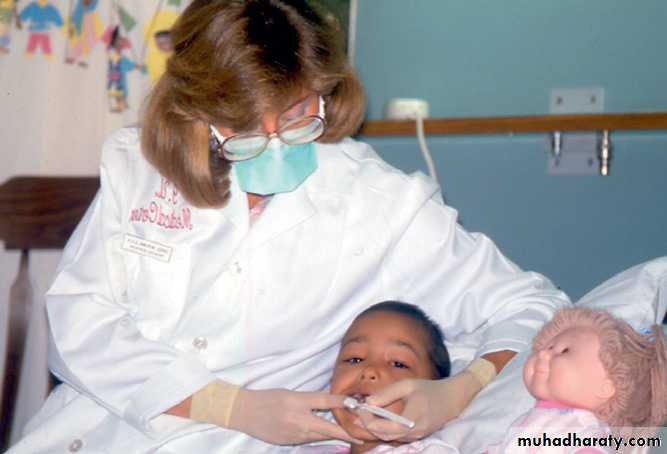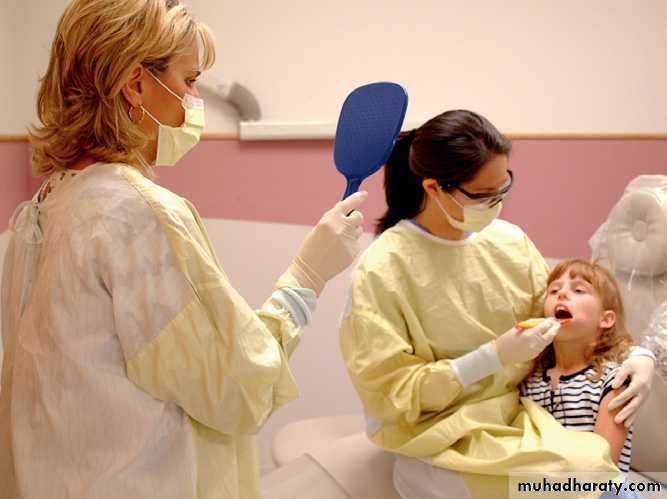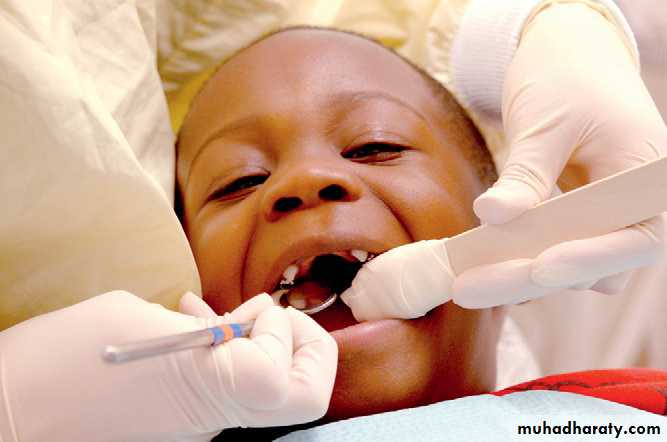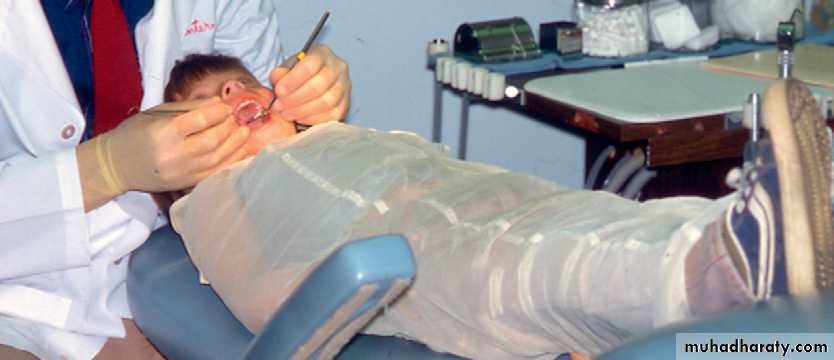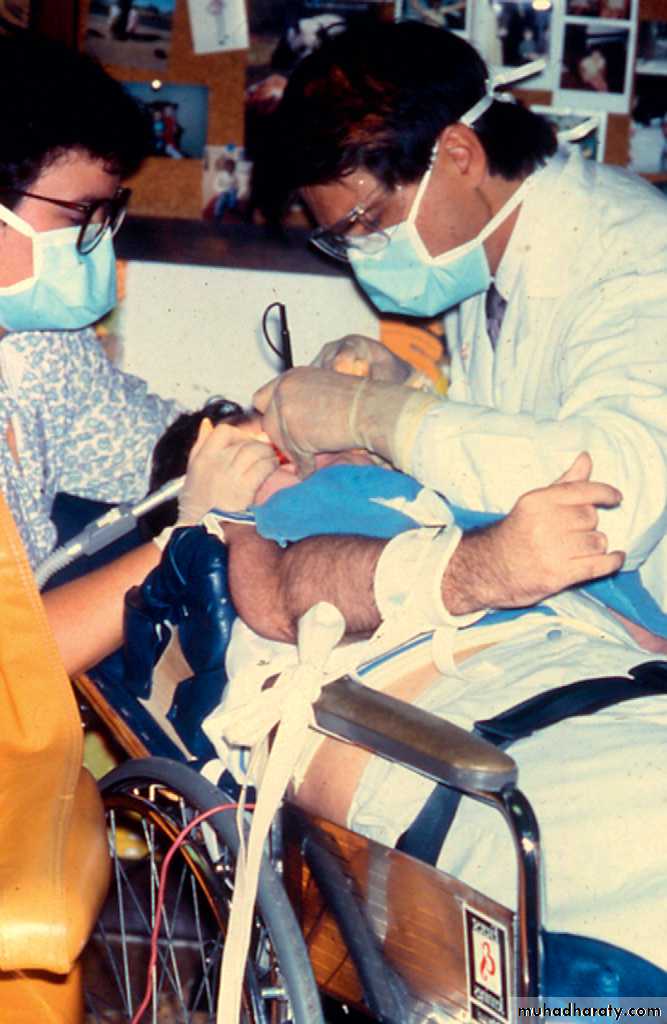Dental Problems of Children
with Special Health Care Needsأطفال \ خامس اسنان
د. سعد م1
9\ 5\ 2017
The American Academy of Pediatric Dentistry defines individuals with special health care needs (SHCN) as those with “any physical, developmental, mental, sensory, behavioral, cognitive, or emotional impairment or limiting condition that requires medical management, health care intervention, and/or use of specialized services or programs.
FIRST DENTAL VISIT
The first dental appointment is very important and can set the stage for subsequent appointments.In many situations, parents or guardians do not realize the importance of this visit and desire treatment immediately.
1- scheduling the patient at a designated time (early in the day)
2- allowing sufficient time to talk with the parents (or the guardian)3- the patient before initiating any dental care, a practitioner can establish an excellent relationship with them
RADIOGRAPHIC EXAMINATION
Better cooperation may be elicited from some children by delaying radiographs until the second visit, when they are familiar with the dental office and have found it a friendly place.An 18-inch (46-cm) length of floss is attached through a hole made in the tab to facilitate retrieval of the film if it falls toward the pharynx.
the patient should wear a lead apron with a thyroid shield, and anyone who helps hold the patient and the film or sensor steady should wear a lead-lined apron and gloves.
HOME DENTAL CARE
The parents (or the guardian) are initially responsible for establishing good oral hygiene in the homeThe dentist should teach the parents to gently cleanse the incisors daily with a soft cloth or an infant toothbrush.
For older children who are unwilling or physically unable to cooperate, the dentist should teach the parent or guardian to clean teeth twice a day using correct tooth brushing techniques
Positions most commonly used for children requiring oral care assistance are as follows:
• The standing or sitting child is placed in front of the adult so that the adult can cradle the child’s head with one hand while using the other hand to brush the teeth..
• The child reclines on a sofa or bed with the head angled backward on the parent’s lap. Again, the child’s head is stabilized with one hand while the teeth are brushed with the other hand.
• The parents face each other with their knees touching. The child’s buttocks are placed on one parent’s lap, with the child facing that parent, while the child’s head and shoulders lie on the other parent’s knees; this allows the first parent to brush the teeth.
• The extremely difficult patient is isolated in an open area and reclined in the brusher’s lap. The patient is then immobilized by an extra attendant while the brusher institutes proper oral care. If a child cannot be adequately immobilized by one person, then both parents and perhaps siblings may be needed to complete the home dental care procedures.
• The standing and resistive child is placed in front of the caregiver so that the adult can wrap his or her legs around the child to support the torso while using the hands to support the head and brush the teeth
The use of protective stabilization is indicated in the
following situations:1• A patient requires immediate diagnosis and/or limited
treatment and cannot cooperate because of lack ofmaturity, mental or physical disability.
2• A patient requires diagnosis or treatment and does not
cooperate after other behavior management techniqueshave failed.
3• The safety of the patient, staff, parent or practitioner
would be at risk without the use of protective stabilization.MANAGEMENT OF A CHILD WITH SPECIAL HEALTH CARE NEEDS DURING DENTAL TREATMENT
The use of stabilization is contraindicated in the following
situations:1• A cooperative non-sedated patient.
2• Patients who cannot be safely stabilized due to medicalor physical conditions.
3• Patients who have experienced previous physical or
psychological trauma from protective stabilization.4• Non sedated patients with non emergent treatment requiring lengthy appointments.
Wrapped tongue blades
Open Wide disposable mouth prop
Molt Mouth Prop
McKesson bite blocks
The following are commonly used for protective stabilization:Body
Papoose Board (Olympic Medical Corp., Seattle, Wash)Triangular sheet
Pedi-Wrap (The Medi•Kid Co., Hemet, Calif)
Beanbag dental chair insert
Safety belt
Extra assistant
Extremities
Posey straps (Posey Co., Arcadia, Calif)
Velcro straps
Towel and tape
Extra assistant
Head
Forearm-body supportHead positioner
Plastic bowl
Extra assistant
Papoose Board
Patient confined in a triangular sheet with leg straps
Patient in a Pedi-Wrap
Patient lying in a beanbag dental chair insert
Posey strap on wrist
Towel and tape on forearm
DENTAL TREATMENT OF A PERSONWITH INTELLECTUAL DISABILITY
Children with intellectual disability may have a higher
incidence of poor oral hygiene, gingivitis, malocclusion,and untreated caries. As the severity of intellectual disability increases, typical oral signs of clenching, bruxing, drooling, pica, trauma, missing teeth, and self-injurious behaviors increase.
The following procedures have proved beneficial in establishing dentist-patient-parent-staff rapport and reducing the patient’s anxiety about dental care:
1. Give the family a brief tour of the office before attempting
treatment..2. Be repetitive; speak slowly and in simple terms.
3. Give only one instruction at a time.4. Actively listen to the patient.
5. Invite the parent/guardian into the operatory for assistance
and to aid in communication with the patient when helpful.6. Keep appointments short.
7. Schedule the patient’s visit early in the dayDOWN SYNDROME (TRISOMY 21 SYNDROME)
The incidence of congenital cardiac defects is about 40%, and because of these patients’ high susceptibility to periodontal disease, knowledge of a heart condition is essential for dental treatment.Children with Down syndrome have a 10- to 20-fold greater incidence of leukemia during infancy compared with the general population. This increased incidence of leukemia is not maintained later in life.
Children with Down syndrome experience a high incidence of rapid, destructive periodontal disease, which may be related to local factors such as tooth morphology,
bruxism, malocclusion, and poor oral hygiene.
Many children with Down syndrome are affectionate and cooperative, and dental procedures can be provided without compromise if the dentist works at a slightly slower pace.
LEARNING DISABILITIES
Today the term learning disabled is applied to children who exhibit a disorder in one or more of the basic psychological processes involved in understanding or using spoken or written language.
Most children with learning disabilities accept dental care and cause no unusual management problems for the dentist. If a child is resistant, behavioral management and conscious sedation techniques can be used with success.
FRAGILE X SYNDROME
Fragile X is an X-linked developmental disorder. It accountsfor 30% to 50% of cases of X-linked mental disability.
Mode of dental treatment depends on the level of developmental delay, cognitive ability, and degree of hyperactivity.
Those with mild cases may be treated by scheduling short appointments and using immobilization and/or conscious sedation.
Severely affected individuals must be treated in the operating room under general anesthesia.
FETAL ALCOHOL SPECTRUM DISORDER
Fetal alcohol spectrum disorder (FASD) is an umbrella termthat describes the range of effects that may occur with
maternal consumption of alcohol during pregnancy.
it is likely that the alcohol affects the normal development of the neural crest cells. With growth deficits, central nervous system abnormalities.
AUTISM SPECTRUM DISORDER
Autism spectrum disorder (ASD) is an incapacitating disturbance of mental and emotional development that causes problems in learning, communicating, and relating to others.
Children with ASD have multiple medical and behavioral problems that make dental treatment difficult. These children often have poor muscle tone, poor coordination, drooling, a hyperactive knee jerk, and strabismus.
The use of a Papoose Board or Pedi-Wrap and pre appointment conscious sedation may be necessary and in some instances has a calming effect on the child.
CEREBRAL PALSY
1. Monoplegia—involvement of one limb only2. Hemiplegia—involvement of one side of the body
3. Paraplegia—involvement of both legs only
4. Diplegia—involvement of both legs with minimum
involvement of both arms
5. Quadriplegia—involvement of all four limbs

